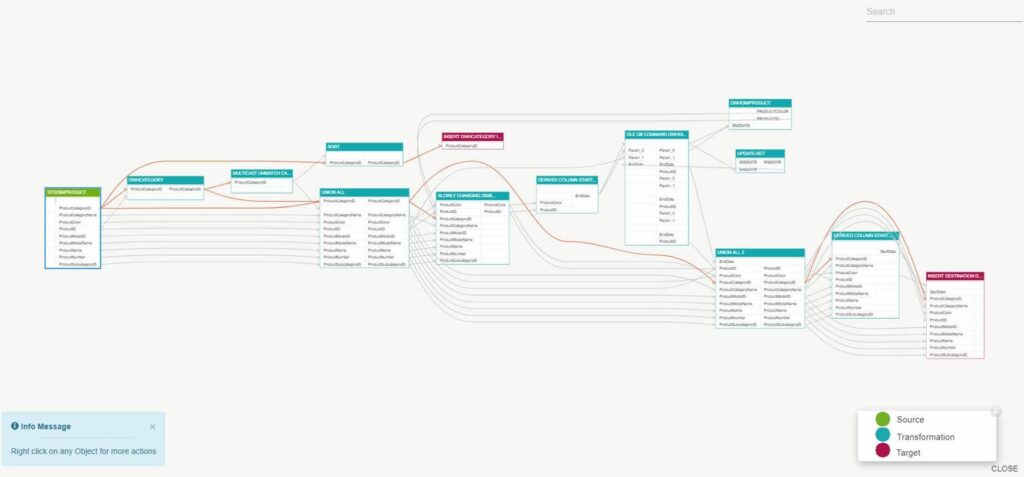Embarking on a data-driven journey requires understanding the intricate paths data takes within your organization. Enter the world of data lineage – the invisible threads that trace the journey of information from its origin to its utilization. In this blog post, we unravel the significance of data lineage, exploring how it enhances transparency, boosts trust, and empowers organizations to make informed decisions based on a clear understanding of their data’s genealogy.
Defining Data Lineage
Data lineage is the comprehensive record of the journey that data takes from its origin, through various transformations and processing steps, to its final destination or consumption within an organization. Think of it as the DNA of data, documenting its lifecycle and providing a detailed map of how information flows through different systems, applications, and processes. This lineage typically includes details about the source systems, the transformations applied at each step, and the ultimate destinations or uses of the data. Understanding data lineage is crucial for ensuring transparency, traceability, and trust in the data, allowing organizations to make informed decisions, comply with regulations, and troubleshoot issues by retracing the path of data throughout its lifecycle.
The Importance of Data Lineage
Data lineage holds immense importance in the realm of data management as it serves as a vital compass for organizations navigating the complex landscape of information. Firstly, data lineage enhances transparency by providing a clear and detailed map of how data evolves from its source to its ultimate utilization. This transparency not only fosters trust in the data but also aids in compliance efforts, allowing organizations to demonstrate the integrity and accuracy of their data to regulatory bodies and stakeholders.
Secondly, data lineage is instrumental in boosting confidence in decision-making processes. By understanding the lineage of data, organizations gain insights into potential areas of improvement, troubleshoot issues more effectively, and optimize data workflows. It becomes a powerful tool for data governance, enabling better control over data quality and integrity. Ultimately, data lineage empowers organizations to make informed, strategic decisions by ensuring a thorough understanding of the data’s journey and its impact on various business processes.
Tracing the Journey

Tracing the data journey with data lineage involves mapping and documenting the flow of data from its source to its consumption. Here are key steps to effectively trace data lineage:
Identify Data Sources: Begin by identifying and documenting the primary sources of data within your organization. These sources could include databases, applications, external feeds, or any system generating or collecting data.
Document Transformation Processes: Trace how data undergoes transformations and modifications as it moves through various processes. Document any ETL (Extract, Transform, Load) processes, data cleansing, or enrichment steps that occur along the way.
Define Data Destinations: Clearly define where the data ultimately ends up or how it is consumed. This could include data warehouses, reporting systems, analytics platforms, or any applications that utilize the data for decision-making.
Tracing the journey of data, or establishing data lineage, necessitates several prerequisites for an effective and accurate process. First and foremost, organizations must have a comprehensive understanding of their existing data landscape, including documentation of data sources, systems, and storage locations. Clear data governance policies and metadata management practices are essential to provide context, quality information, and ownership details for the traced data. Access to and utilization of data integration tools, data catalogs, and data discovery platforms contribute significantly to automating and visualizing the data journey. Collaboration among cross-functional teams, including IT, data stewards, and business users, is crucial for obtaining insights into data dependencies and ensuring alignment with organizational goals. Lastly, a proactive approach to maintaining and updating data lineage documentation is vital to reflect changes in data architecture and business processes over time. Overall, a combination of technological tools, organizational collaboration, and a well-established data governance framework is essential for successful data journey tracing.
Challenges and Best Practices
Data lineage, while invaluable for understanding and managing data flow, comes with its set of challenges. Challenges include dealing with complex and dynamic data environments, especially in large organizations where numerous interconnected systems and sources exist.
- Maintaining accurate and up-to-date lineage documentation can be labor-intensive, particularly as data landscapes evolve.
- Ensuring consistency across disparate data sources, especially in terms of formats and definitions, poses another challenge.
- Best practices for overcoming these challenges involve adopting automated data lineage tools to streamline documentation processes.
- Fostering a culture of collaboration between IT and business teams, and implementing robust metadata management practices.
- Regular audits and reviews of data lineage documentation, along with proactive updates to reflect changes, contribute to its accuracy.
- Emphasizing data governance and standardization practices across the organization helps address consistency challenges, ultimately ensuring that data lineage remains a reliable and valuable asset for decision-making processes.
Conclusion
As organizations navigate the complex landscape of data management, embracing the concept of data lineage becomes pivotal. From fostering transparency to bolstering trust, the insights gained from understanding data lineage lay the foundation for more effective decision-making in an era where data integrity is paramount.


